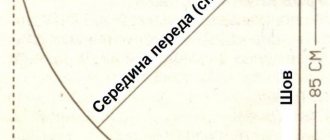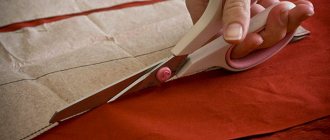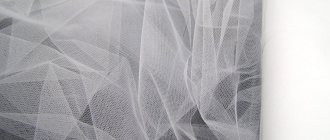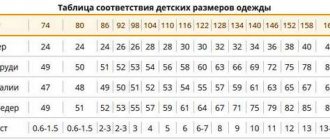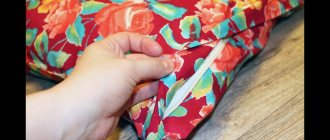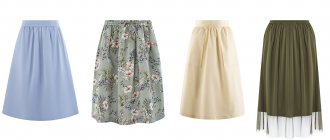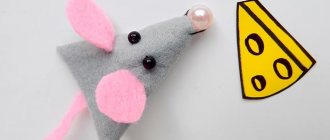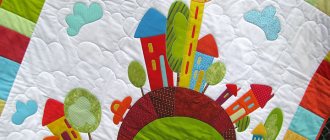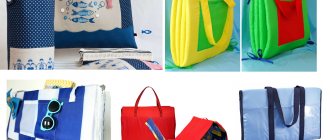Lush tulle skirts have long remained the prerogative of holidays, children's matinees or hen parties. But now eclecticism is in fashion and therefore such a bright model could not remain aside. However, choosing the perfect cut, size and length is quite problematic. And why, if in just a couple of hours you can sew a tulle skirt with your own hands! You won't even need a sewing machine. Let's talk!
Tulle skirt with frills
This skirt is always made on a backing to which you will sew ruffle ribbons. To calculate the appropriate cut size, double the waist circumference, and add 4 cm to the length for the hem. Finish the longitudinal sides with an overlocker or stitch with a zigzag, stretch the lining on a flat base and turn in the top edge by 2 cm, but do not stitch it yet.
Spread a wide piece of tulle about 2.5-3 m long and cut into ribbons of 10-13 cm each. Gather four such ribbons into a frill using large basting stitches and do not be alarmed by the resulting length - it will still go away. Fold each in half and sew at the fold with a seam using the longest stitches and tension.
When you finish all the ruffles, distribute them evenly over the backing and secure each one separately. The first one is laid on top along the bottom of the bend, and the rest are distributed in parallel with the required pitch. Stitch each frill in the center so that they evenly cover the backing.
Fold the backing in half with the right side with the tulle facing in and sew opposite edges. After this, sew the top fold and insert an elastic band into it - this will be the waistband of the skirt. All that remains is to turn the product inside out, remove all the marks and manually straighten the frills.
Lined tulle skirt
In addition to 3-6 m of tulle, you will also need a piece of satin fabric to match. Cut the tulle into strips to suit the length of the skirt you need and gather each strip on top - this will be a belt. It is most convenient to do this manually using large basting stitches or using a special foot for a sewing machine.
The length of the gathered part should be equal to the circumference of the hips with 2-3 cm at the seams. Sew each layer separately along the side line, and then assemble them all together. If the skirt turns out to be quite thick and voluminous, you can leave it without a lining, but with it it will be more comfortable and durable.
Draw out the satin fabric for the petticoat: this is what the pattern for the hips with a girth of 90 cm will look like. You will need two such pieces, which you will then sew on the sides with an overlocker or overcast the edges with a zigzag. All that remains is to fold and stitch the hem twice - and you can proceed to assembly.
Take a wide elastic band and cut a piece 3 cm smaller than your waist circumference, and then sew the edges together. If you immediately take the decorative elastic band, you can proceed to connecting the parts. First, baste the tulle skirt with a satin lining, and only then sew on the elastic, gently stretching it.
How to sew elastic into a skirt waistband: basic tutorials
There are several ways to sew an elastic band instead of a belt, but it is recommended to focus on the methods most commonly used by professionals.
Zigzag method
The most suitable option for owners of sewing machines that have a zigzag stitch. But even if you have to work manually, it will be easy to attach the tape to the material in this way.
Zigzag method
This method can be used to sew both elastic tape and thread. Its advantage is that even an elastic band can be stitched evenly without additional marks or fixations.
Attaching the belt to the skirt is carried out in the following sequence:
- The elastic band of the required length is measured and prepared. It is better to make two blanks - one of them will be needed for fitting.
- One of the ribbons is pulled under the foot of the sewing machine, and a zigzag is selected along it with such a step that it does not pierce the elastic threads - the needle should pass through the fabric, and not through them. As a result, it should be so that the elastic moves freely inside the seam.
- When the entire strip is under the zigzag seam, a second sample is applied next to it, and marks are made on the sewn tape corresponding to the edges of the attached piece.
- The elastic under the zigzag seam is pulled to the required length. You should select the required tension for the finished product and secure the tape with several stitches located at the same distance from each other.
You might be interested in how a beginner can sew dresses for dolls with his own hands
Finished product with a belt sewn with a zigzag
Rocker method
Performed in the following sequence:
Rocker method
- The length of the line along which the elastic will be attached is measured.
- A strip of material of the same length is measured. The width of the material must be at least the width of the elastic band plus seam allowances.
- A fabric drawstring is sewn along the line of the waistband.
- A rubber band is pulled through the resulting “tunnel” using a pin. Its end and beginning are attached to the skirt fabric.
Ready-made skirt with drawstring
Seamless tulle skirt
To make the skirt fluffy and voluminous, you will need a large piece of tulle - from 10 m. To it - a strip of dense fabric of a matching color, 13-15 cm wide and 8-10 cm longer than the waist circumference. And also a wide long ribbon around the waist with allowances for ties - it will be used instead of an elastic band.
Mark and cut all the tulle into strips of approximately 17-20 cm. Take one strip, fold it in half and tighten it with a loop knot on the ribbon, as shown in the photographs. Repeat this with all the cuts - the more of them and the tighter they are, the fuller the skirt will be. After this, you can leave the skirt like this with ties at the ends or sew on an even belt made of thick fabric to match.
Materials and tools for work
In order to get started, you need to prepare the following tools in advance:
- To take measurements and draw a pattern, you will need a measuring tape.
- Tailor's scissors and pins.
- Threads in a color that matches the tone of the fabric.
- To simplify the work, it is recommended to have a sewing machine.
You might be interested in this Instructions for sewing files, sheets and folders with thread yourself
Required Tools
It is also worth preparing materials to start sewing:
- Elastic tape more than 30 mm wide. You can choose plain or multi-colored.
- Fabric for the skirt.
Important! The amount of material is taken based on the selected style of the item of clothing. For a half-sun or pleated skirt no more than 60 cm long, take a piece of fabric measuring 150 × 160 cm.
Tape selection
Seamless skirt with checkerboard elastic
This tulle skirt is similar to the previous one, but instead of a ribbon you will need a wide checkered elastic band. Do not tie tulle ribbons through the top, but pull them through the elastic holes. To make it more convenient to work, first stretch it and fix it, for example, on a book.
Thread the tulle strips into the second row - if you leave them very low, they may come out over time. When the elastic ends, the first layer of the seamless pack is ready. But you can always make it more voluminous: just repeat all the manipulations, but for the third row of holes, helping yourself with a pen or any other thin object.
Features of the material
Tulle is considered a decorative fabric due to its mesh texture and translucency. It is used as an addition to the creation of clothing. Rigidity depends on the size of the cells, the thickness of the mesh and the components in the composition. Highlight:
- Soft material. Used to create children's clothes and linings for fabric for greater pomp.
- Medium hardness. Standardly used in tailoring adult models. The tulle layer allows you to make the skirt elegant.
- Hard type. Used for decorative purposes for interior design, making toys.
Depending on the presence of spraying, it can be either matte or with glossy tints. Options are available with glitter and additional prints for decoration. You can buy the material in specialized stores. To create a tulle skirt for a girl with your own hands, it is better to buy soft material - eurotulin.
Thanks to its strength, translucency and fine texture, the material fits well on other fabrics and does not cover their surfaces, but creates a light haze.
From fabric you can make:
- Ballet tutus.
- Petticoats.
- Christmas costumes.
- Midi skirts for girls.
The fabric is easy to clean and does not absorb moisture; it can be hemmed, decorated with embroidery or decorated with interesting stripes. The mesh texture is ideal for experimentation.
Tulle circle skirt
To make a circle skirt, you need to fold a square piece of tulle into four layers and transfer the pattern onto it. But keep in mind that one layer will be too thin, light and unremarkable. You will need at least 3-4, and better yet, even more. Basically, all you have to do is collect all the circles, stitch them on top and stretch the elastic.
Multilayer tulle skirt
You will need a large piece of wide tulle - from 6 m, and a ribbon for the belt. Cut the canvas into several pieces 1.9-2.1 m long, fold each in half lengthwise and cut along the fold. From a 6-meter fabric with a width of 1.2-1.5 m you will get six 2-meter fragments.
Take two parts each and overlap them together along the short sides, leaving 20 cm unstitched at the top edge. Gather all the layers together and pin them together at the top. Take a strong, dense thread and stretch it through all the layers along the future belt. It is best to loop two such seams at a short distance so that the folds are uniform. Tighten the basting threads and adjust the gathers by hand so that they are evenly distributed throughout the fabric. As a result, you should have a width around your waist. After this, the threads need to be secured and a wide ribbon belt sewn on top.
